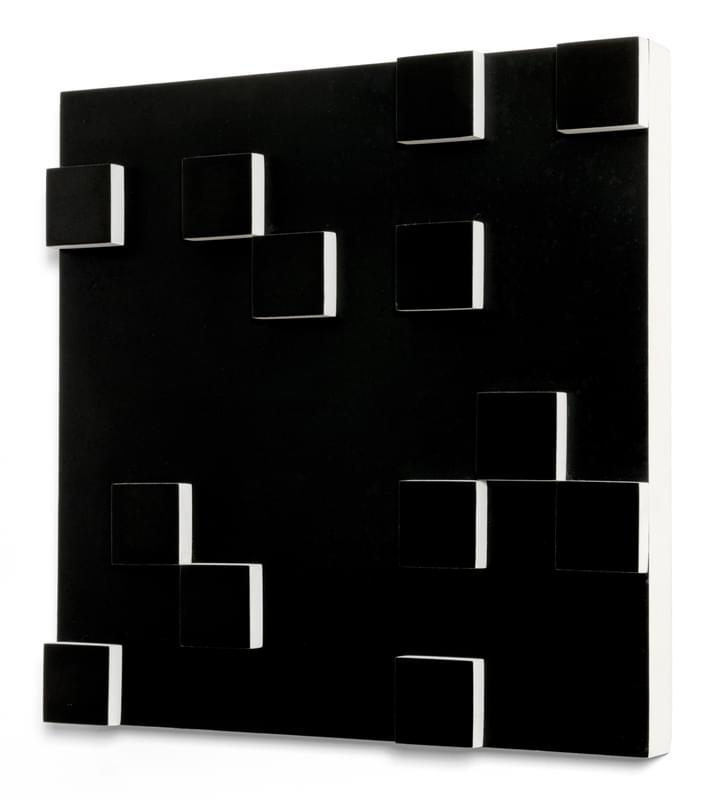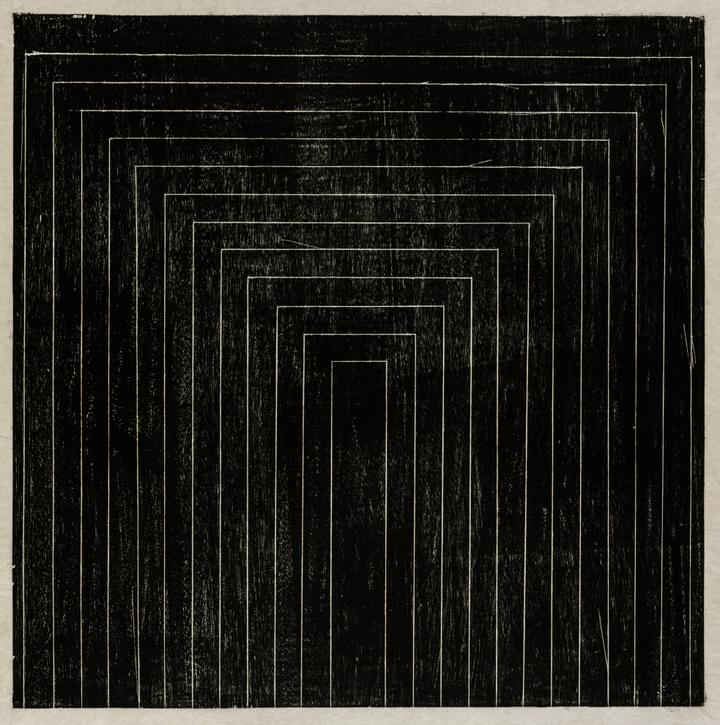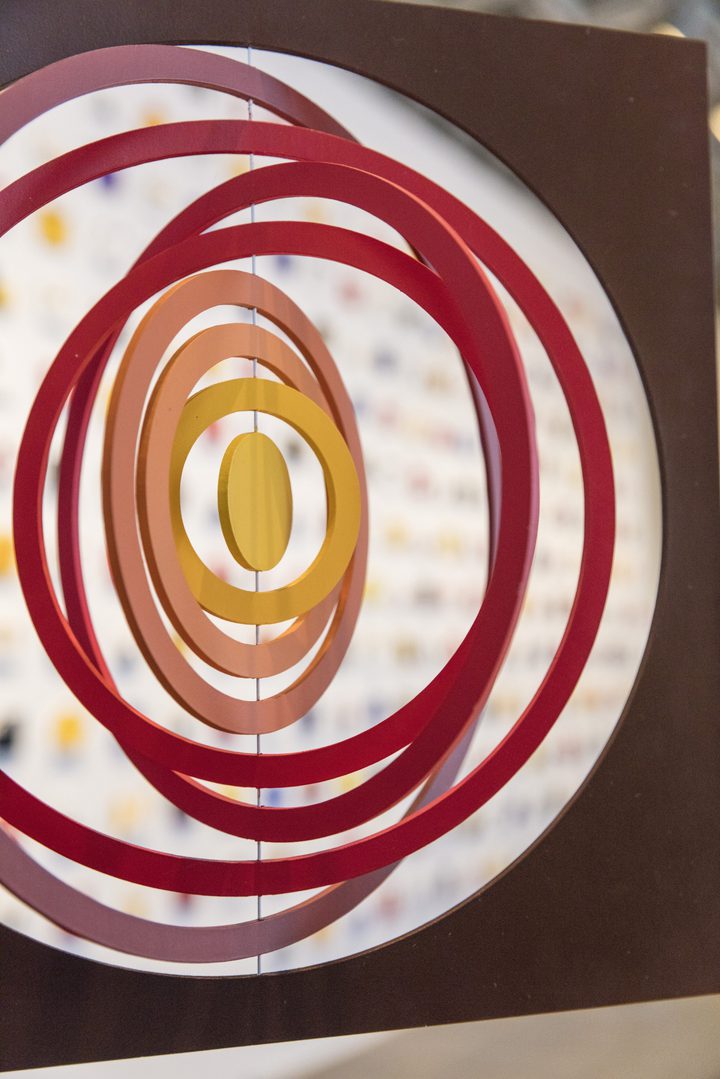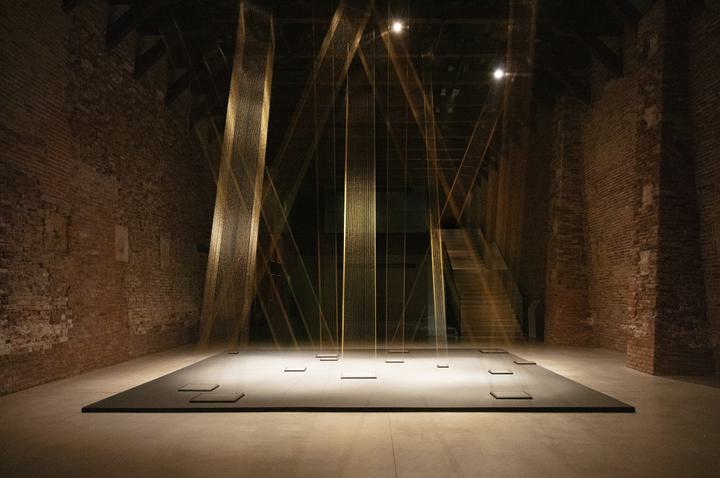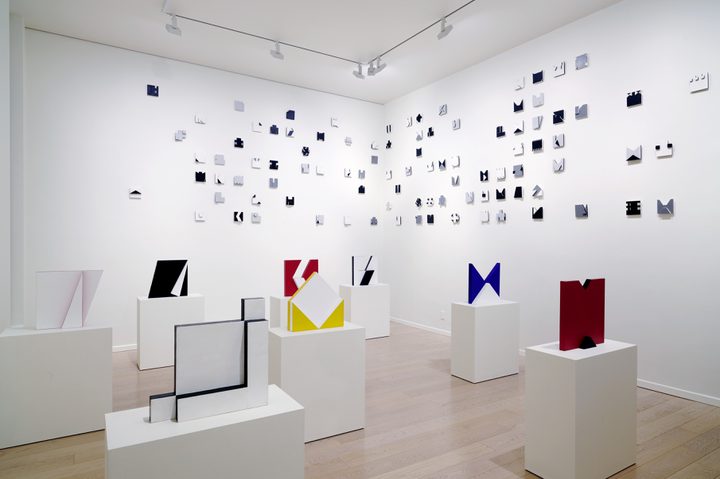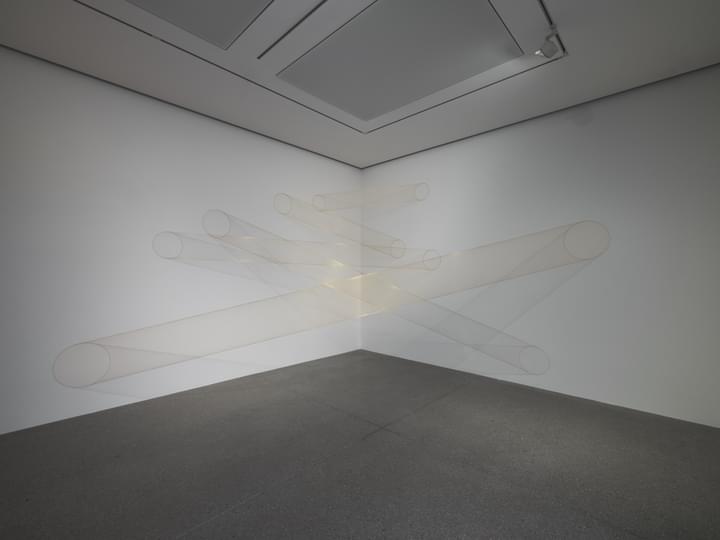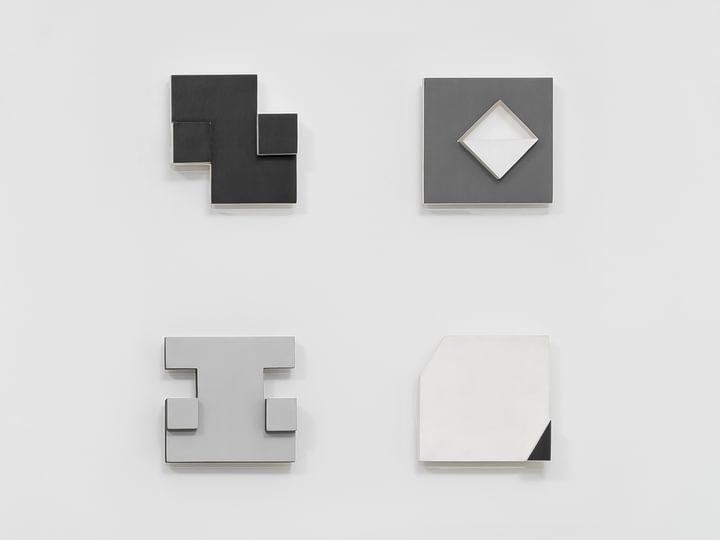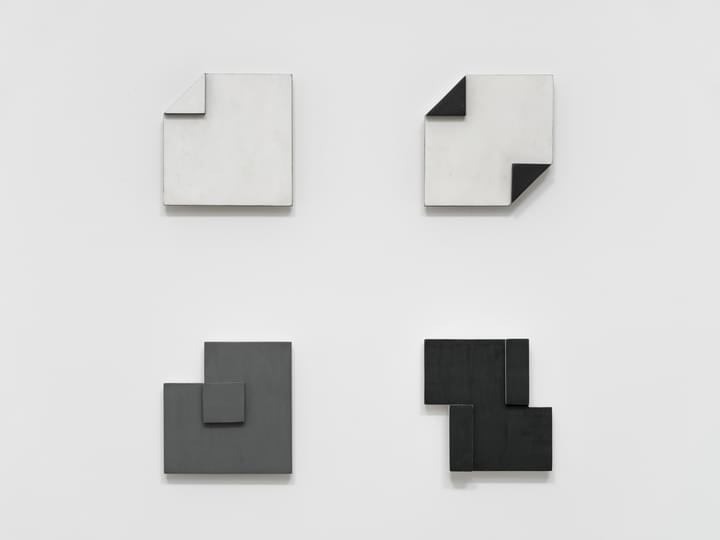Born in Nova Friburgo, Brazil in 1927 and coming of age at the close of the Second World War, Pape’s early interest in geometric abstraction deviated from the artistic conventions of the era, which tended towards the figurative – often explicitly in service to Brazilian nationalist agendas. In the early 1950s, she began her formal art studies at the Museu de Arte Moderna do Rio de Janeiro, where she became affiliated with the avant-garde collective Grupo Frente. Founded by the artist and teacher Ivan Serpa and comprising fellow artists Hélio Oiticica, Lygia Clark and Aluísio Carvão, the group renounced the tenets of Brazilian modernism, instead, seeking a form of enigmatic abstraction that was, from the outset, untethered from observed reality.
While most members focused on painting and sculpture as the best form to express concrete ideals, Pape developed an affinity for woodblock printing, initiating her formative series of geometric abstract prints in 1953, which she later referred to as ‘Tecelares’ (‘Weavings’). Reinterpreting the woodcut process, wherein multiple editions would typically be produced, Pape’s ‘Tecelares’ were conceived as singular works that favoured the primacy of expression over reproductive modalities. Distancing the medium from its traditional associations with folk imagery and political propaganda, Pape’s woodcuts materialised compositions of overlapping geometric and linear elements. Dislodged forms – mirrored and multiplied – seemingly released within expanses of negative space, forged a sensual interplay of geometry and space. Pape termed this dynamic ‘magnetised space’ – a quality that would come to define her wider practice.
During that same period, Pape began to redefine the interaction between the viewer and two-dimensional representation, integrating the artwork as an interface within its environment. In her series of ‘Paintings’ and ‘Reliefs’, created between 1954 and 1956, the works extend into space through sequenced geometric forms that protrude from the wooden canvas. Engaging the viewer in a dynamic spatial encounter, the reliefs give rise to a perceptive paradox wherein the forms are fused to the bidimensional plane while simultaneously crafting the illusion of floating independently within space.
Expanding her investigations into the dynamics of objects in space, she ventured into video and performance art in 1958 with the staged Ballet Neoconcreto, inspired by a poem from the poet and modernist Reynaldo Jardim. Accompanied by an atonal electronic soundtrack, the ballet featured dancers concealed within chromatic cylindrical and cuboid shapes performing choreographed movements across a stage. The work demonstrates a synergy between form and space reminiscent of the ‘Tecelares’, yet one that was now entirely liberated from the confines of the two-dimensional surface.
In 1959, Pape, along with Oiticica and Clark, signed the Neo-Concrete manifesto authored by Ferreira Gullar. The manifesto established the foundational principles of the movement, diverging from Concrete art in advocating for heightened sensuality, liberated colour and an embrace of phenomenology in real-time and space. Conceived in the same year, Pape’s Livro da Criação (Book of Creation), a part-book-part-sculptural work designed to narrate the genesis of the world, epitomised the Neo-Concrete ethos. Executed across 16 unbound pages, the work comprised colourful 30 x 30cm units in which geometric patterns and abstract glyphs could be unfolded and opened out into a three-dimensional abstract shape. As viewers interacted with the work, each was invited to manipulate the pages in different ways to reveal unique chronologies. Pape suggested that ‘two readings are possible: to me, this is the book of the creation of the world, but for others, it could be just the book of creation.’
The Book of Creation initiated a series of book works that chronicled temporality. Expanding on the scope of the first book, Pape’s subsequent Livro do tempo (Book of Time) (1961–63), consolidated 365 three-dimensional units, each designed to represent a single day of the year. Coinciding with her involvement with the film group Cinema Novo, Livro Noite e Dia (Book of Night and Day) (1963–76), maintained this scope, comprising 365 singular components that could be fragmented or cut, akin to the process of editing a film, with each individual part representing a single frame in a movie.
Evolving from these foundational explorations, Pape’s monumental 1968 performance work, Divisor, became one of her most significant contributions to the exploration of artist-viewer engagement. The idea for the work had its origins in the sensory interactions between the body and its environment, primarily inspired by her visits to the beach, where she would immerse her body in the water, leaving only her head exposed to observe others doing the same. Coming into contact with solid, liquid, air and the social environment, Pape sought to replicate in Divisor the diverse sensations that a single body could experience in a given moment. Transposing this corporeal experience, the central element comprised a vast single sheet of white fabric, punctuated by strategically arranged apertures, allowing participants to insert their heads through the fabric and move as a collective body through the streets of Rio de Janeiro. In the shared performance of Divisor, Pape dismantled the boundaries between artwork and viewer, creating an embodied space of individual and collective resistance against the imposed censorship and constraints on personal freedoms which were taking place in Brazil at the time.
Pape returned to the Museu de Arte Moderna as a teacher from 1969 to 1971 and, from 1972 to 1988, taught semiotics at the Universidade Santa Ursula. Throughout the 1960s and ’70s, she devoted much of her practice to film, using it as a vehicle to explore metaphorical, existential and sensorial experiences. Through film, for example in O ovo (1967) and Eat Me (1975), she probed the limitations of existence and the objectified human body, believing in the multifaceted potential of recreation and regeneration.
Between 1989 and 1992, Pape developed a series of sculptures titled ‘Amazoninos’, large iron wall-mounted geometrical works which alluded to the forms and aerial perspectives of the Amazon rainforest. Manipulating iron with a suppleness akin to thin paper, these works appear to spring forth from the walls, eliding the weight of their industrial composition and embodying both geometric precision and organic fluidity. Around the same period, she felt the desire to return to the planar surface of painting, creating a series of canvases that combined different textures to play with the depth of a matte surface and the perception of the ‘light’ in the materials.
In the latter decades of her life – from 1976 to the early 2000s – Pape dedicated herself to a series of geometric installations entitled ‘Ttéia’ – a semantic play on the Portuguese words ‘teia’ (meaning ‘web’) and ‘teteia’, connoting a person or entity of grace. Composed of accumulations of gold or silver threads, these intricate woven installations traverse the confines of an interior space, extending from the floor to the ceiling or spanning from one corner to another to form luminous columns of light. Arranged in a staggered configuration, the columns splice and intersect, while overhead lighting accentuates the oblique pillars as a sequence of interfaces. These threads, in turn, absorb and reflect the light, casting shadows and patterns into the surrounding environment. Since her death in 2004, the ‘Ttéia’ series has emerged as one of Pape’s most celebrated works, evoking the woven geometries of her formative ‘Tecelares’ prints and emblematising her career-long investigations into spatial dynamics, geometric abstraction and interactivity.
Lygia Pape (1927–2004) was born in Nova Friburgo and died in Rio de Janeiro, Brazil. Her solo exhibitions include Art Institute of Chicago, Illinois (2023); Kunstsammlung Nordrhein-Westfalen, Düsseldorf, Germany (2022); Moderna Museet, Stockholm (2018); The Metropolitan Museum of Art and Met Breuer, New York (2017); ‘Magnetized Space’, Museo Nacional Centro de Arte Reina Sofía, Madrid; Serpentine Gallery, London; and Pinacoteca do Estado de São Paulo, Brazil (2011–12); Serralves Museum of Contemporary Art, Porto, Portugal (2000); and CAMJAP, Lisbon (2000). Selected group exhibitions include Pinault Collection / Punta della Dogana, Venice, Italy (2023); MoMA, New York (2009); 53rd Venice Biennale (2009); Contemporary Brazilian Art Museum of Contemporary Art, Tokyo (2008); Barbican Centre, London (2006); Museum of Contemporary Art, Chicago, Illinois (2005); Haus der Kunst, Munich, Germany (2004); Museu de Arte Moderna, São Paulo, Brazil (2004); 50th Venice Biennale (2003); Solomon R. Guggenheim Museum, New York (2001–02); and Museum of Contemporary Art, Los Angeles, California (1998).
Her work is held in international public collections including Art Institute of Chicago, Illinois; Centre Pompidou Paris; Culturgest – Fundação Caixa Geral de Depósitos, Lisbon; Colección Patricia Phelps de Cisneros, Caracas, Venezuela and New York; Collection Fundação de Serralves – Museu de Arte Contemporânea, Porto, Portugal; Glenstone Foundation, Potomac, Maryland; Hammer Museum, Los Angeles, California; Instituto Inhotim, Brumadinho, Brazil; Kunstsammlung Nordrhein-Westfalen, Düsseldorf, Germany; Metropolitan Museum of Art, New York; Museo Nacional Centro de Arte Reina Sofía, Madrid; Museum of Contemporary Art, Chicago, Illinois; Museum of Fine Arts, Houston, Texas; MoMA, New York; and Tate, London.

